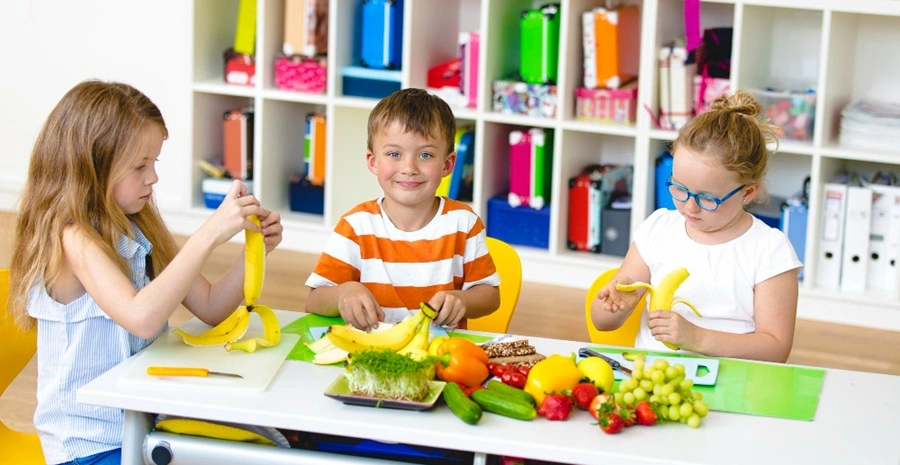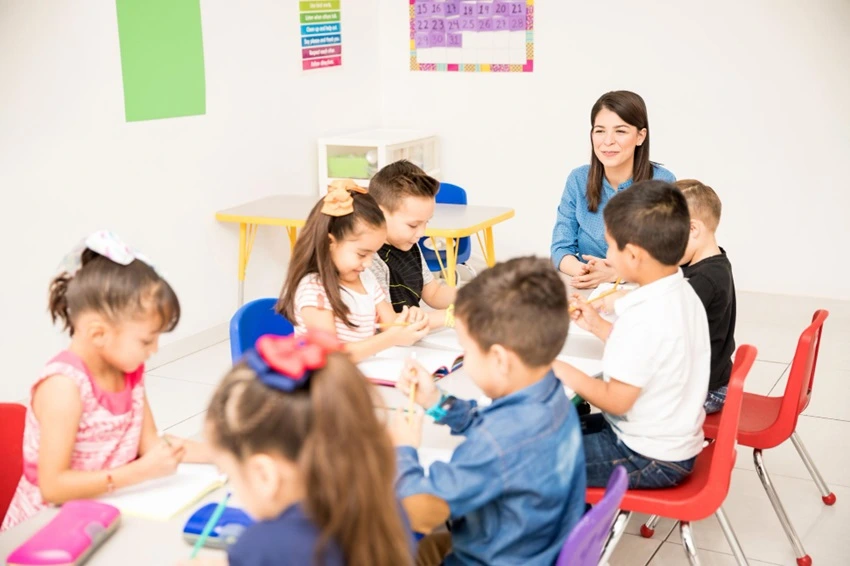Table of Contents
In today’s world, where childhood wellness often competes with fast‑food, screen time and hectic schedules, the educational environment plays a pivotal role not just in what children learn, but how they learn and how their bodies support that learning. The philosophy of Maria Montessori is deeply rooted in the idea of educating the whole child, mind, body and spirit. This blog post explores how health and nutrition integrate seamlessly with the Montessori method (and particularly how aspiring teachers and educators in India/Asia can apply these principles), why this matters, and the actionable tips you can adopt or teach in your classroom.
If you are a parent curious about Montessori education or an aspiring Montessori teacher looking to enrich your practice, you’ll find the ideas here relevant, practical and deeply aligned with the holistic vision of children’s learning.
Register for the Entri Elevate Montessori Teacher Training Program! Click here to join!
Why Health and Nutrition Matter in a Montessori Context
When we talk about nutrition, we often think: “Feed the body so the child grows”. But in a Montessori setting, nutrition is much more than calorie counts or lunch‑boxes. It’s intertwined with independence, sensory experience, prepared environment, choice and self‑care.
The body‑mind connection
Montessori education emphasises that movement and body awareness are not separate from intellectual development. As one article puts it:
“Movement helps the development of the mind, and this finds renewed expression in further movement and activity.”
Healthy nutrition underpins that movement and growth: when a child is well‑nourished, their physical health supports concentration, coordination, sensory exploration and emotional regulation.
Creating lifelong habits early
A recent study found that a Montessori‑based nutrition education programme significantly improved children’s knowledge of nutrition and introduced healthier eating behaviours.
In other words: implementing nutrition and health education in early years is not extra, it’s part of how we prepare children for life. Montessori classrooms are perfectly positioned for this because they emphasise practical life skills, sensory experiences, and real‑world independence.
Alignment with Montessori philosophy
If we look at the core of Montessori: the prepared environment, the child’s independence, choice within limits, sensorial learning, all of these support healthy habits. For example: allowing children to serve their own fruit, use child‑sized utensils, participate in meal preparation, making food part of practical life activities. Montessori classrooms become micro‑communities of wellness.
One blog summarises it neatly:
“At its core, Montessori education is about preparing the whole child for life… what does this entail in today’s world? It means empowering children with a foundation of wellness practices…”
For educators and aspiring teachers, that means your role goes beyond “teaching letters and numbers”. You become a guide for healthy habits, part of the child’s ecosystem of well‑being.
What a Montessori‑Friendly Health & Nutrition Approach Looks Like
1: What is the primary focus of the first plane of development in the Montessori method?
Here are concrete ways how the Montessori method supports health and nutrition, and how you can apply them.
1. Practical Life Activities with Nutrition Focus
- Children participating in preparing snacks, cutting fruit, washing vegetables, setting the table, these tasks develop coordination, independence and respect for food.
- Using sensory work: exploring textures, colours, smells of food; helping children engage their senses so they learn about nutrition through experience rather than abstract instruction.
- Serving themselves in child‑sized portions. Children feel empowered when they choose from a pre‑approved set of healthy options (choice within limits).
2. Prepared Environment
- Arrange snack/table areas where children can reach items independently. Low shelves with fruit, child‑sized plates and utensils.
- Encourage unhurried, mindful meals: no distractions, children sitting together, enjoying food and conversation. This builds awareness of hunger/fullness cues, respect for food.
- Integrate movement and nutrition: children transition from activity to snack, learn that their body needs rest or nourishment, etc. Movement supports learning of health.
3. Harvesting, Gardening & Food Origins
Though not always present in urban classrooms, the idea of helping children understand where their food comes from helps build appreciation and healthy behaviour. Sensory gardens, fruit/vegetable planting, visiting markets, all fit with Montessori’s emphasis on reality‑based learning and environment.
4. Independence, Responsibility, Self‑Care
In Montessori, children are seen as capable from a young age. In terms of nutrition:
- They choose between two healthy options, serve themselves, clean up.
- They learn that their body needs healthy food, that they are partly responsible for their nourishment.
- Teachers guide, not dictate, so children internalise healthy habits rather than simply obeying rules.
5. Collaboration with Families & Community
Because habits are formed both at school and at home, Montessori health approaches often include parent education, shared snack systems or lunches, communication with families on healthy choices. For schools in India especially, aligning with local food culture matters. One early blog emphasised: “…within a few weeks… children bringing more nutritional meals and snacks to school, we observed improved behaviour and attention in our Montessori students.”
Get Certified & Start Your Montessori Career
Montessori Teacher Training Course by Entri App: Gain expert skills, earn certification, and kickstart your teaching career.
Join Now!Why This Matters
If you’re based in India (or similar contexts in Asia), these points bear special relevance:
- Fast food and processed snacks are on the rise , which makes introducing healthy habits in the early years more crucial than ever to help kids build some resilience against unhealthy eating habits.
- You can draw on local cultural food traditions to create healthy habits: think local fresh fruits and veggies, legumes, home-cooked meals. The thing is Montessori nutrition education doesn’t have to be about importing Western food models – you can root it in what’s local and familiar to the culture.
- We’re seeing more teacher training in India; as someone who’s aspiring to be a Montessori educator, you can actually bring health & nutrition into your curriculum and environment from the very start.
- Unfortunately India’s still facing some real challenges when it comes to childhood health indicators – growth, nutrition, activity – in a lot of regions. Integrating health, nutrition, and Montessori pedagogy can really contribute to some broader social good.
- When Montessori classrooms reflect the local culture – food, movement, community – kids develop a sense of connection and belonging, which is super important for their overall development.
Health & Nutrition in the Montessori Classroom: A Sample Framework
Here’s a sample weekly plan or module you might offer (either as a teacher or parent‑guide) to integrate health and nutrition in a Montessori environment:
Week 1: Exploring Food Groups & Senses
- Introduce fruits, vegetables, grains, and legumes in a sensory table: feel, smell, and observe.
- Practical life: child washes and prepares fruit for a snack.
- Discussion: “What does your body need to move, think, grow?”
- Take‑home: Send parent note asking for one fruit/vegetable from home that the child can explore.
Week 2: Independent Serving & Meal Time Culture
- Set‑up child‑sized tableware and utensils. Children serve themselves from bowls of chopped fruit/veg.
- Mindful snack time: no screens, conversation about taste/texture/where the food comes from.
- Practical life: child helps clean up and takes responsibility for table.
- Discussion: “When we eat slowly and choose food ourselves, how does our body feel?”
Week 3: Movement + Nutrition
- Combine an “exercise/active” practical life period (walk on the line, gross‑motor movement) followed by a snack. Reflect: “When we move, our body uses energy; when we eat healthy, we replenish.”
- Sensory work: show whole grain vs refined grain, show legumes, pulses. Children explore with tools.
- Parent‑school connection: invite parents to share a healthy snack from home and talk about it.
Week 4: Food Origins & Growing
- Gardening or plant‑based activity: plant seeds (if space allows) or show how vegetables grow.
- Ask children: “Where did this carrot come from? What path did it take to reach our plate?”
- Practical life: child peels or chops vegetables for a small group cooking/prep activity.
- Conclusion reflection: children talk about favourite snack, how they felt, what they learned about food and body.
This module can be repeated or adapted across age‑groups, from early childhood (2½‑6 yrs) to elementary. The key is consistency, involvement, and self‑chosen healthy behaviours.
Key Takeaways for Parents, Educators & Aspiring Montessori Teachers
- Nutrition is not an add‑on, it’s integral to Montessori education. Supporting physical health supports intellectual, emotional and social development.
- Prepared environment + independence = healthy habits. When children serve themselves, explore food, participate in meals, they build ownership and respect for nourishment.
- Sensory and Practical Life activities create strong food‑literacy. Feeling textures, washing produce, choosing snacks: these give children agency and curiosity about food.
- Movement and nutrition go hand in hand. Montessori emphasises whole‑body development. Ensuring children are active and well‑nourished empowers learning.
- Local context matters. In India/Asia, using local foods, involving families, reflecting culture strengthens relevance and sustainability of nourishing habits.
- Teacher training strengthens outcomes. Educators trained in Montessori methods (including health and nutrition integration) are better placed to create holistic learning spaces.
- The ripple effect. When a classroom emphasises healthy habits, children carry those habits home, influencing families and communities.
Get Certified & Start Your Montessori Career
Montessori Teacher Training Course by Entri App: Gain expert skills, earn certification, and kickstart your teaching career.
Join Now!How the Entri Montessori Teacher Training Course Fosters a Deeper Understanding of Integration
If you’re thinking about developing your skills as a Montessori educator, the Entri course is an investment worth considering. Here’s how it aligns with health and nutrition integration:
- The course drops you right into the heart of Montessori philosophy – the prepared environment, practical life, and sensorimotor development – giving you a solid foundation to build on with health and nutrition.
- You’ll learn how to create classroom activities that go way beyond academics – using movement, self-care and practical life to encourage healthy habits in a really natural way.
- The training puts a big emphasis on child-centred learning, independence and respect – which makes it easy to implement nutrition-inclusive practices like child-led snack prep, “food exploration” and mindful meals.
- You’ll get a good understanding of what makes a great classroom set-up, material choices and environment design – which means you can create a space where food, movement and health are just part of the learning process, not something separate.
- If you’re in India or one of the surrounding regions, the Entri course will help you adapt the global Montessori philosophy to local contexts – including food, local ingredients, cultural practices and family participation.
In short: by joining the Entri montessori course, you won’t just be teaching maths, language and sensorimotor skills – you’ll be nurturing whole children: their bodies, minds and overall wellbeing.
The Last Word
Montessori education is a rich and varied world, but at its heart, it’s all about being human. When we respect a child’s body, their capacity, support their independence and instill healthy habits from an early age, we’re doing something pretty profound. We’re preparing kids not just for school, but for life.
For parents reading this: think about how the way you approach meals, snacks, and food culture in your home might be supporting independence and wellbeing. And for anyone looking to become a Montessori educator: just imagine what your classroom might be like if food, movement, self-care, independence, and curiosity are woven into your daily routine.
When nutrition becomes a key part of the way we design our educational settings, not just something that gets added on at the end, you end up with a really thriving environment. A well-nourished, active, empowered and curious child who’s able to explore their food choices and learn in a prepared environment will really learn better, feel better, and grow more harmoniously.
If you’d like, I can share a detailed lesson plan set (for ages 3-6 and 6-9) on integrating health & nutrition in Montessori classrooms – just let me know!
So what’s next? Consider signing up for the Entri Montessori Teacher Training Course today and start designing classroom environments where wellbeing, nourishment and learning go hand in hand.
Register for the Entri Elevate Montessori Teacher Training Program! Click here to join!
Key Takeaways
- Montessori education’s all about holistic development – health and nutrition are integral parts of the approach, not optional add-ons.
- You need a prepared environment, sensory activities, and kid-led meal experiences to support healthy eating habits.
- Movement and body awareness complement nutrition in really nurturing the whole child.
- When applying Montessori in Indian/Asian contexts, local foods, family involvement, and cultural alignment are key.
- Teacher training (such as Entri’s course) empowers educators to implement these practices in a way that’s tailored to their own context.
- And the ultimate goal: raising independent, curious, healthy kids who are ready for whatever life throws at them.
| Also Read | |
| 5 Ways Montessori Teacher Training Benefits Children | |
| What Qualifications Do You Need for Kindergarten Teacher Jobs? |
|
| Montessori Pink Tower Making | |
| Knobbed Cylinders in Montessori | |
Get Certified & Start Your Montessori Career
Montessori Teacher Training Course by Entri App: Gain expert skills, earn certification, and kickstart your teaching career.
Join Now!Frequently Asked Questions
Why is nutrition important in Montessori education?
Nutrition directly affects concentration, memory, and mood. A well-nourished child can focus longer, learn better, and stay emotionally balanced, all essential for Montessori learning.
How does Montessori teaching include nutrition in daily activities?
Through Practical Life exercises like washing fruits, serving food, and pouring water — children learn hygiene, independence, and healthy habits naturally.
What kind of foods are recommended in Montessori schools?
Fresh fruits, vegetables, whole grains, and light proteins are preferred. Processed snacks and sugary foods are discouraged to promote energy stability and focus.
How do teachers ensure hygiene in a Montessori environment?
Montessori classrooms include child-sized sinks, daily hand-washing routines, clean eating areas, and regular sanitisation to maintain hygiene and reduce illness.
Can nutrition be integrated into learning lessons?
Yes. Nutrition can be woven into counting (e.g., sorting fruits), language (naming foods), and science (learning about growth and food sources), making learning practical and enjoyable.
How does good health support cognitive development in children?
Physical well-being boosts brain development, memory retention, and emotional stability, all vital for Montessori’s self-paced, focused learning model.
What role does rest and sleep play in Montessori education?
Adequate rest helps children consolidate learning, maintain emotional balance, and stay attentive during classroom activities.
How can Montessori educators handle allergies or special diets?
Teachers maintain an allergy registry, plan inclusive menus, and involve parents to ensure safety and participation for every child.
How can parents support Montessori nutrition principles at home?
Parents can offer balanced meals, involve children in simple cooking tasks, and align home routines with the school’s health practices for consistency.
How can aspiring Montessori teachers learn about classroom health management?
Through structured programs like the Entri Montessori Course, educators learn how to integrate health, nutrition, and hygiene practices into lesson planning and daily classroom management.
















